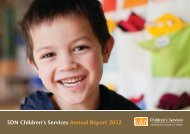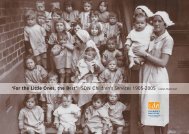SDN Children's Services Inc. Annual Report 2010
SDN Children's Services Inc. Annual Report 2010
SDN Children's Services Inc. Annual Report 2010
You also want an ePaper? Increase the reach of your titles
YUMPU automatically turns print PDFs into web optimized ePapers that Google loves.
Our history<br />
To preserve family life, to educate mothers in child health and to save babies from death and becoming state wards.<br />
‘The charter written by the founders of <strong>SDN</strong><br />
‘<br />
Our proud history<br />
One hundred years ago there were very few options for child<br />
care. Many working mothers were forced to leave young children<br />
either with relatives or older siblings or unattended. To reduce<br />
the risk of harm, some mothers locked children in the house,<br />
whilst others locked them out. The 1904 Royal Commission on<br />
the Decline of the Birth-Rate and on the Mortality of Infants<br />
in NSW found that approximately one in ten children did not<br />
survive infancy and that more than 50 percent of these deaths<br />
occurred in the first three months of life.<br />
In response to the Royal Commission and spurred on by the<br />
exclusion of children under three years of age from Kindergarten<br />
Union centres, a group of young women established the<br />
Sydney Crèche Association and opened <strong>SDN</strong>’s first centre in<br />
Woolloomooloo. It was the first formal child care service to<br />
open in NSW specifically for working mothers of children aged<br />
under three years of age, and was well patronised.<br />
For a modest fee of threepence a day, working women<br />
now had a safe place to entrust their children from<br />
7:00am to 6:30pm. There was little recognition of the word<br />
crèche and within a few months of opening our name was<br />
changed to The Sydney Day Nursery Association. The health<br />
of children was a major concern: before the 1930s, nurseries<br />
were run by matrons and supported by nurses.<br />
The fees received were not enough to run the nursery, and<br />
in the absence of any government support the Association<br />
relied heavily on fundraising. This was the largest source of<br />
income until World War I.<br />
Between 1905 and 1930 <strong>SDN</strong> expanded to 11 centres. The<br />
history of <strong>SDN</strong> during the Great Depression is testimony to<br />
the determination and ingenuity of the Association’s leaders.<br />
These women were incredibly resourceful and managed<br />
not only to keep the nurseries afloat, but to pioneer early<br />
education in the midst of the Great Depression. When <strong>SDN</strong><br />
was in serious financial trouble and even as the Executive<br />
Committee was considering closing at least one centre, they<br />
were taking steps towards training and appointing teachers<br />
in the nurseries. At the time, such a decision must have<br />
been viewed as reckless; in retrospect it was courageous and<br />
visionary.<br />
At the forefront of early childhood<br />
education<br />
<strong>SDN</strong> has long been at the forefront of early childhood education.<br />
In the 1930s <strong>SDN</strong> was the first to combine a preschool program<br />
with long day care by training and employing qualified early<br />
childhood teachers in the nurseries.<br />
In 1931 the Sydney Day Nursery and Nursery Schools<br />
Association established the first training centre for nursery<br />
school teachers in NSW, at Woolloomooloo Nursery. The<br />
establishment of the Nursery School Training Centre (later<br />
Training College then Teachers’ College) responded to an<br />
urgent need for ‘properly trained teachers’ to work in the<br />
newly founded nursery schools.<br />
According to an early prospectus (circa 1939), the purpose<br />
of the Nursery School Training College was:<br />
to offer to the students a professional training in educational<br />
principles and modern methods of teaching children ranging<br />
in age from 18 months to 6 years. Although the training is a<br />
broad and cultural one, special emphasis is laid on the scientific<br />
study of the needs and development of young children.<br />
Initially a two-year course, the training was expanded in<br />
1942 to a three-year diploma course. From its earliest days,<br />
the training was holistic. Subjects taught were scientific,<br />
artistic, and aimed at supporting parenting. They included<br />
Psychology, Hygiene, Child Welfare, Eurhythmics, Infant<br />
Welfare and Mental Health, and Child Development.<br />
Many of the principles on which the Nursery School<br />
Training Centre was founded resonate soundly with <strong>SDN</strong>’s<br />
contemporary practices. Just as our forebears did, we recognise<br />
the importance of understanding the multiple individual,<br />
familial, social, cultural and political factors that affect young<br />
children’s lives, and we continue to advocate strenuously for<br />
‘properly trained teachers’ in early childhood settings.<br />
Many of the core values on which <strong>SDN</strong> was built remain<br />
relevant to this day. <strong>SDN</strong> remains true to the Association’s<br />
initial mission: we continue to operate as a not-for-profit<br />
18 <strong>SDN</strong> <strong>Annual</strong> <strong>Report</strong> <strong>2010</strong>





